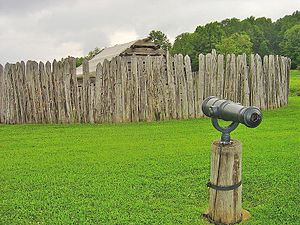
Back Fort-Nesessiti döyüşü Azerbaijani Batalla de Great Meadows Catalan Batalla de Great Meadows Spanish Fort Necessityn taistelu Finnish Bataille de Fort Necessity French Battaglia di Fort Necessity Italian ネセシティ砦の戦い Japanese 네세시티 요새 전투 Korean Slaget ved Fort Necessity NN Slaget ved Fort Necessity NB
| Battle of Fort Necessity | |||||||
|---|---|---|---|---|---|---|---|
| Part of the French and Indian War | |||||||
 A modern-day reconstruction of Fort Necessity | |||||||
| |||||||
| Belligerents | |||||||
|
Algonquin Odawa Huron[1] |
| ||||||
| Commanders and leaders | |||||||
|
|
| ||||||
| Strength | |||||||
|
600 regulars and militia 100 Indians[2][3] |
100 regulars 293 provincials[4][3] | ||||||
| Casualties and losses | |||||||
|
3 killed 19 wounded |
31 killed 70 wounded 369 captured[5] | ||||||
The Battle of Fort Necessity, also known as the Battle of the Great Meadows, took place on July 3, 1754, in present-day Farmington in Fayette County, Pennsylvania. The engagement, along with a May 28 skirmish known as the Battle of Jumonville Glen, was the first military combat experience for George Washington, who was later selected as commander of the Continental Army during the American Revolutionary War by the Second Continental Congress in Philadelphia.[6]
The Battle of Fort Necessity began the French and Indian War, which later spiraled into the global conflict known as the Seven Years' War. Washington built Fort Necessity on an alpine meadow west of the summit of a pass through the Laurel Highlands of the Allegheny Mountains. Another pass nearby leads to Confluence, Pennsylvania; to the west, Nemacolin's Trail begins its descent to Uniontown, Pennsylvania, and other parts of Fayette County along the relatively low altitudes of the Allegheny Plateau.
- ^ Dixon, David (Summer 2007). "A High Wind Rising: George Washington, Fort Necessity, and the Ohio Country Indians". Pennsylvania History: A Journal of Mid-Atlantic Studies. 74 (3): 333–353. doi:10.2307/27778785. JSTOR 27778785. S2CID 248875228.
- ^ Cite error: The named reference
lengel42was invoked but never defined (see the help page). - ^ a b "help Necessity". NPS.
- ^ Cite error: The named reference
lengel40was invoked but never defined (see the help page). - ^ Sheppard, p. 48
- ^ "Ten Facts About George Washington and the French & Indian War". George Washington's Mount Vernon. Retrieved July 3, 2018.
© MMXXIII Rich X Search. We shall prevail. All rights reserved. Rich X Search